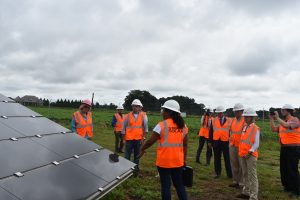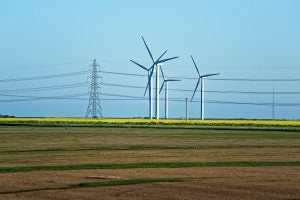
This summer, Environmental Defense Fund (EDF) and The Nature Conservancy (TNC) collaborated with First Baptist Church in Mount Olive, North Carolina to host an event to explore the new opportunities solar energy is providing for the church and Wayne County.
We spent most of the day together and heard how First Baptist Church is benefitting from solar energy projects situated a couple of miles from the church. The church has provided land for two solar installations, built by Birdseye Renewable Energy and owned and operated by Strata Solar, a Chapel-Hill based solar developer. The solar farm we all toured generates more than 10,000 MWh of energy every year.
Speakers included Senior Pastor Dennis Atwood and Angelo San Fratello, President of Trustees.
“It’s a matter of stewardship for us and we didn’t want the land to be developed for some purpose that would be contrary to the mission of our church,” Atwood said. “And solar farming is clean energy, and it’s a good use of the earth and it essentially goes back to providing power for almost an entire town.” Read More










 Resiliency is a hot button word right now. Ten years ago, advocates focused on “adaptation,” or the idea of adapting to the coming effects of climate change. Now the focus is on “resiliency,” the ability to bounce forward – not backward – when something disastrous happens.
Resiliency is a hot button word right now. Ten years ago, advocates focused on “adaptation,” or the idea of adapting to the coming effects of climate change. Now the focus is on “resiliency,” the ability to bounce forward – not backward – when something disastrous happens. Crain’s Cleveland Business first published
Crain’s Cleveland Business first published  By Rebecca Goold, clean energy consultant
By Rebecca Goold, clean energy consultant More than a year and a half after the Aliso Canyon natural gas storage facility caused more than 100,000 tons of methane to leak into the atmosphere – amounting to be our nation’s largest-ever gas leak, California regulators continue to labor away at improving the rules that could prevent another gas storage disaster.
More than a year and a half after the Aliso Canyon natural gas storage facility caused more than 100,000 tons of methane to leak into the atmosphere – amounting to be our nation’s largest-ever gas leak, California regulators continue to labor away at improving the rules that could prevent another gas storage disaster. By Monica Kanojia, Consultant, U.S. Department of Energy
By Monica Kanojia, Consultant, U.S. Department of Energy